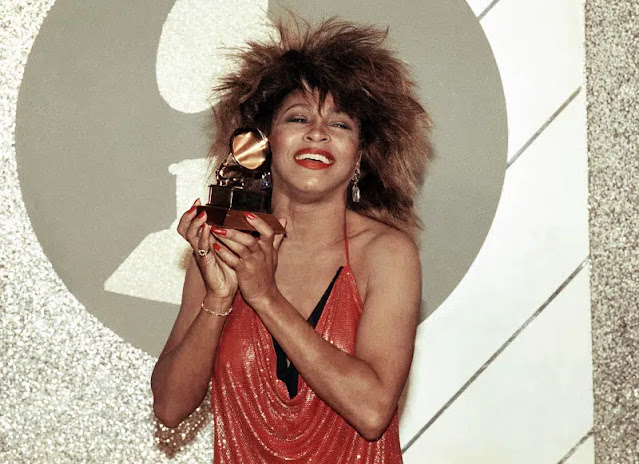(AP) — In 1976, a young Tina Turner, bloodied and beaten by her husband and musical partner Ike Turner, fled in the dark across a Dallas freeway dodging trucks and cars with only pennies in her pocket.
That moment when she decided she’d had enough of the physical, sexual, and emotional abuse was a turning point for the “Queen of Rock ‘n’ Roll,” who would go on to have a musical renaissance in the 1980s. After the Rock & Roll Hall of Famer and worldwide star died Wednesday at 83, tributes often remarked on her courage in the face of horrifying violence.
But her story of surviving and thriving was so much more than a comeback, cultural and domestic abuse experts say. Turner’s reclaiming of her career and her humanity on her own terms made her a pioneering Black woman who refused to be defined by abuse.
Turner detailed that night in her 2021 documentary, “Tina,” describing the euphoria she felt: “I was very proud. I felt strong. I had never done this.” She made the difficult decision to tell that part of her life in interviews and biography, later adapted into the hit biopic “What’s Love Got To Do With It.”
Raven Maragh-Lloyd, an assistant professor at Washington University in St. Louis, said the thread of the strong Black woman is limiting when applied to women like Turner, whose career blended multiple musical genres, acting, and a distinct visual aesthetic.
“So much of her story has been told through the lens of being a survivor or how much she has overcome to be the superstar, all of which is relevant and true,” Maragh-Lloyd said. “At the same time, we risk erasing her emotions, her feelings, and what that must have been like to go through that abuse.
“That’s a part of her story, not her full humanity,” Maragh-Lloyd said.
The public image of Ike and Tina Turner, a name he gave her and then trademarked to try to keep her from using, was a brand she had to dismantle, even at a personal cost.
“I wanted to stop people from thinking that Ike and Tina were so positive,” she said in the documentary. “It was that we were such a love team or great team. And it wasn’t like that. So I thought, if nothing else, at least people would know.”
Author Francesca Royster explored Turner’s country roots in her 2022 book, “Black Country Music: Listening for Revolutions,” and noted that her decision to leave Ike stymied her career because of the financial impact and stigma of the divorce.
“She experienced lack of interest by music companies who saw her as a kind of novelty act or as a nostalgia act or washed up,” said Royster, a professor of English at DePaul University. “She hadn’t been credited as having the kind of creative power.”
Carolyn West, a professor of clinical psychology at the University of Washington who focuses her research on marginalized women experiencing sexual and domestic violence, said Turner was facing a long history and pattern of discrediting Black women who are abused.
“It probably was very difficult for people to really believe Ike would have done these things or that she was, in fact, a survivor or wasn’t somehow responsible for the abuse,” West said.
The threads of Turner’s experience in the 1970s stretch all the way to the present-day misogynoir faced by Black female artists like Meghan Thee Stallion and Rihanna, who have both experienced intimate partner violence, West said.
“There’s really almost no space, particularly for Black women, to talk about these experiences,” West said. “In the way Meghan was attacked, the way Rihanna was attacked, it’s almost like you just become revictimized again.”
Turner was undeterred. As she sang in “Proud Mary,” she wasn’t going to approach anything “nice and easy.”
She had control of her career revolution in the 1980s with the album “Private Dancer” and its hit “What’s Love Got To Do With It.” She was a triple threat — singer, actor, and author — and became a worldwide touring phenomenon. She sold more than 150 million records worldwide, won 12 Grammys, was voted into the Rock & Roll Hall of Fame both as a duo and as a solo artist, and was honored at the Kennedy Center in 2005.
Her visual representation on screen and stage as strong, sexual, and feminine with her big, bold hair and toned legs projected her own identity, Royster said.
“She really invented her own unique look with her lion’s mane and her combination of leather and denim and her ability also to really move on those high heels,” Royster said. “Those became trademarks.”
In her later years after her musical retirement in the 2000s, Turner lived a long private life with longtime partner Erwin Bach in Switzerland, no longer beholden to anybody. Maragh-Lloyd said Turner’s acumen served her well till the end.
“She wanted not to be gazed upon by anybody, not to perform for anybody,” Maragh-Lloyd said. “That’s also a lesson: You’re not going to use me up.”
___
For more information, contact the National Domestic Violence Hotline at https://www.thehotline.org/ or 1-800-799-SAFE (7233).


